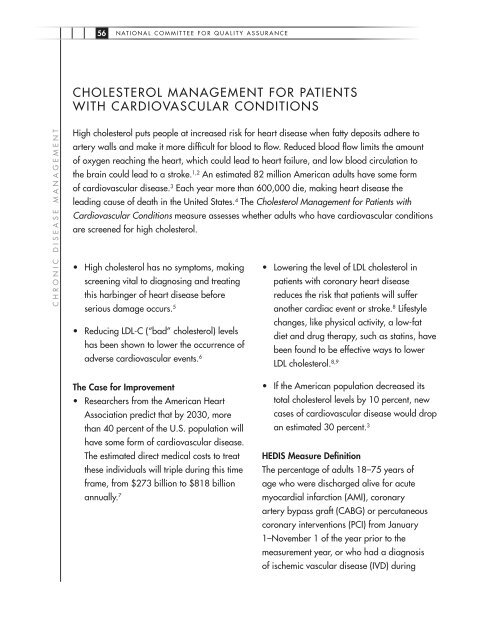Continuous Improvement and the Expansion of Quality ... - NCQA
Continuous Improvement and the Expansion of Quality ... - NCQA
Continuous Improvement and the Expansion of Quality ... - NCQA
You also want an ePaper? Increase the reach of your titles
YUMPU automatically turns print PDFs into web optimized ePapers that Google loves.
C H R o N I C D I S E A S E M A N A G E M E N T<br />
56<br />
High cholesterol puts people at increased risk for heart disease when fatty deposits adhere to<br />
artery walls <strong>and</strong> make it more difficult for blood to flow. Reduced blood flow limits <strong>the</strong> amount<br />
<strong>of</strong> oxygen reaching <strong>the</strong> heart, which could lead to heart failure, <strong>and</strong> low blood circulation to<br />
<strong>the</strong> brain could lead to a stroke. 1,2 An estimated 82 million American adults have some form<br />
<strong>of</strong> cardiovascular disease. 3 Each year more than 600,000 die, making heart disease <strong>the</strong><br />
leading cause <strong>of</strong> death in <strong>the</strong> United States. 4 The Cholesterol Management for Patients with<br />
Cardiovascular Conditions measure assesses whe<strong>the</strong>r adults who have cardiovascular conditions<br />
are screened for high cholesterol.<br />
• High cholesterol has no symptoms, making<br />
screening vital to diagnosing <strong>and</strong> treating<br />
this harbinger <strong>of</strong> heart disease before<br />
serious damage occurs. 5<br />
• Reducing lDl-C (“bad” cholesterol) levels<br />
has been shown to lower <strong>the</strong> occurrence <strong>of</strong><br />
adverse cardiovascular events. 6<br />
<strong>the</strong> Case for <strong>Improvement</strong><br />
• Researchers from <strong>the</strong> American Heart<br />
Association predict that by 2030, more<br />
than 40 percent <strong>of</strong> <strong>the</strong> U.S. population will<br />
have some form <strong>of</strong> cardiovascular disease.<br />
The estimated direct medical costs to treat<br />
<strong>the</strong>se individuals will triple during this time<br />
frame, from $273 billion to $818 billion<br />
annually. 7<br />
N AT I o N A l C o M M I T T E E f o R Q U A l I T y A S S U R A N C E<br />
CHolESTERol MANAGEMENT foR PATIENTS<br />
WITH CARDIoVASCUlAR CoNDITIoNS<br />
• lowering <strong>the</strong> level <strong>of</strong> lDl cholesterol in<br />
patients with coronary heart disease<br />
reduces <strong>the</strong> risk that patients will suffer<br />
ano<strong>the</strong>r cardiac event or stroke. 8 lifestyle<br />
changes, like physical activity, a low-fat<br />
diet <strong>and</strong> drug <strong>the</strong>rapy, such as statins, have<br />
been found to be effective ways to lower<br />
lDl cholesterol. 8,9<br />
• If <strong>the</strong> American population decreased its<br />
total cholesterol levels by 10 percent, new<br />
cases <strong>of</strong> cardiovascular disease would drop<br />
an estimated 30 percent. 3<br />
HEdIs Measure definition<br />
The percentage <strong>of</strong> adults 18–75 years <strong>of</strong><br />
age who were discharged alive for acute<br />
myocardial infarction (AMI), coronary<br />
artery bypass graft (CAbG) or percutaneous<br />
coronary interventions (PCI) from January<br />
1–November 1 <strong>of</strong> <strong>the</strong> year prior to <strong>the</strong><br />
measurement year, or who had a diagnosis<br />
<strong>of</strong> ischemic vascular disease (IVD) during


